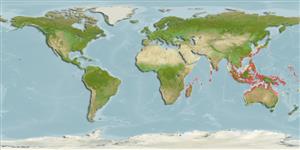Common names from other countries
>
Blenniiformes (Blennies) >
Blenniidae (Combtooth blennies) > Salariinae
Etymology: Mimoblennius: Greek, mimos =mime + Greek, blennios = mucus (Ref. 45335).
More on author: Regan.
Environment: milieu / climate zone / depth range / distribution range
Ekologi
laut berasosiasi dengan karang; kisaran kedalaman 2 - 10 m (Ref. 30874). Tropical
Eastern Indian Ocean and Western Pacific: Sri Lanka and Christmas Island in the Indian Ocean, southern Japan and Hong Kong.
Size / Weight / umur
Maturity: Lm ? range ? - ? cm
Max length : 5.0 cm TL jantan/; (Ref. 30874)
Duri punggung (Keseluruhan (total)): 13; duri punggung lunak (Keseluruhan (total)): 18-19; Duri dubur 2; Sirip dubur lunak: 21 - 22. Closely related to Rhabdoblennius, but differs by 13 dorsal spines. Nasal and nuchal cirri palmate. Supraorbital with 2 long, slender cirri.
A rare species (Ref. 559). Adults live in abandoned worm tubes, solitary or in loose groups (Ref. 90102). Oviparous. Eggs are demersal and adhesive (Ref. 205), and are attached to the substrate via a filamentous, adhesive pad or pedestal (Ref. 94114). Larvae are planktonic, often found in shallow, coastal waters (Ref. 94114).
Oviparous, distinct pairing (Ref. 205).
Masuda, H., K. Amaoka, C. Araga, T. Uyeno and T. Yoshino, 1984. The fishes of the Japanese Archipelago. Vol. 1. Tokai University Press, Tokyo, Japan. 437 p. (text). (Ref. 559)
Status IUCN Red List (Ref. 130435)
CITES (Ref. 128078)
Not Evaluated
ancaman kepada manusia
Harmless
penggunaan manusia
informasi lanjut
AcuanBudidaya airprofil budidaya airStrainGenetikaElectrophoresesDiturunkanPenyakit-penyakitPengolahanMass conversion
mitraGambarStamps, Coins Misc.Suara-suaraCiguateraKecepatanTipe renangArea insangOtolithsOtakPenglihatan / visi
Alat, peralatan
laporan khas
muat turun XML
Sumber internet
Estimates based on models
Preferred temperature (Ref.
115969): 24.5 - 29.2, mean 28.4 (based on 2109 cells).
Phylogenetic diversity index (Ref.
82804): PD
50 = 0.5312 [Uniqueness, from 0.5 = low to 2.0 = high].
Bayesian length-weight: a=0.00741 (0.00335 - 0.01640), b=3.02 (2.83 - 3.21), in cm Total Length, based on LWR estimates for this (Sub)family-body shape (Ref.
93245).
Daya lenting (Ref.
120179): Tinggi, Waktu penggandaan populasi minimum kurang dari 15 bulan (Preliminary K or Fecundity.).
Fishing Vulnerability (Ref.
59153): Low vulnerability (10 of 100).
